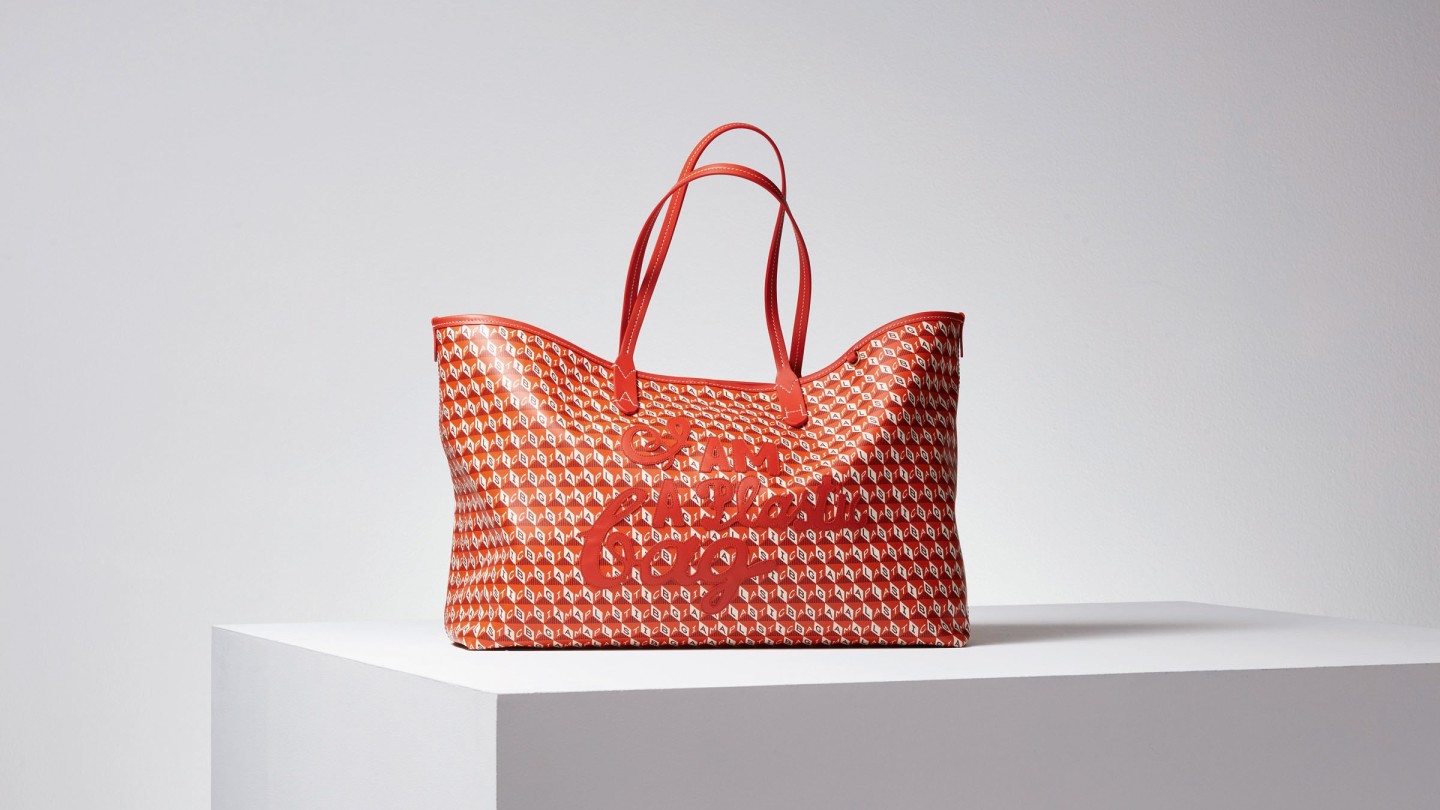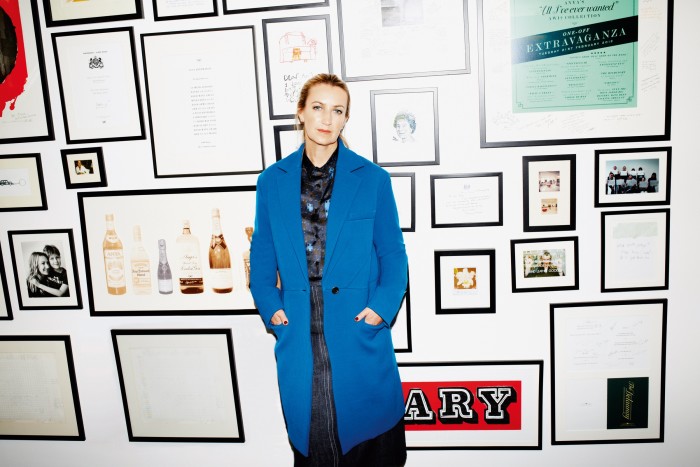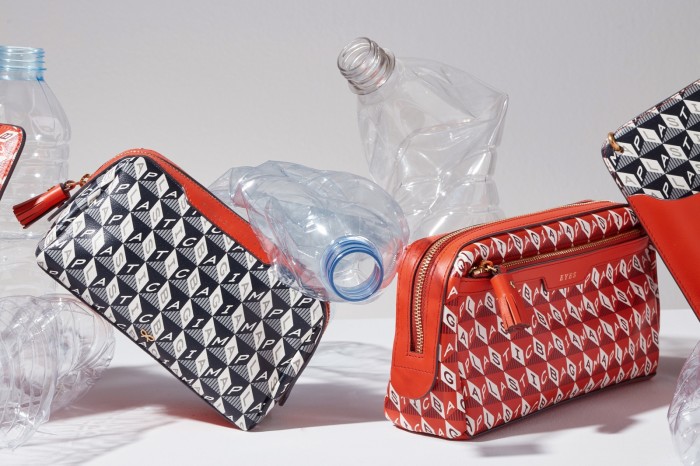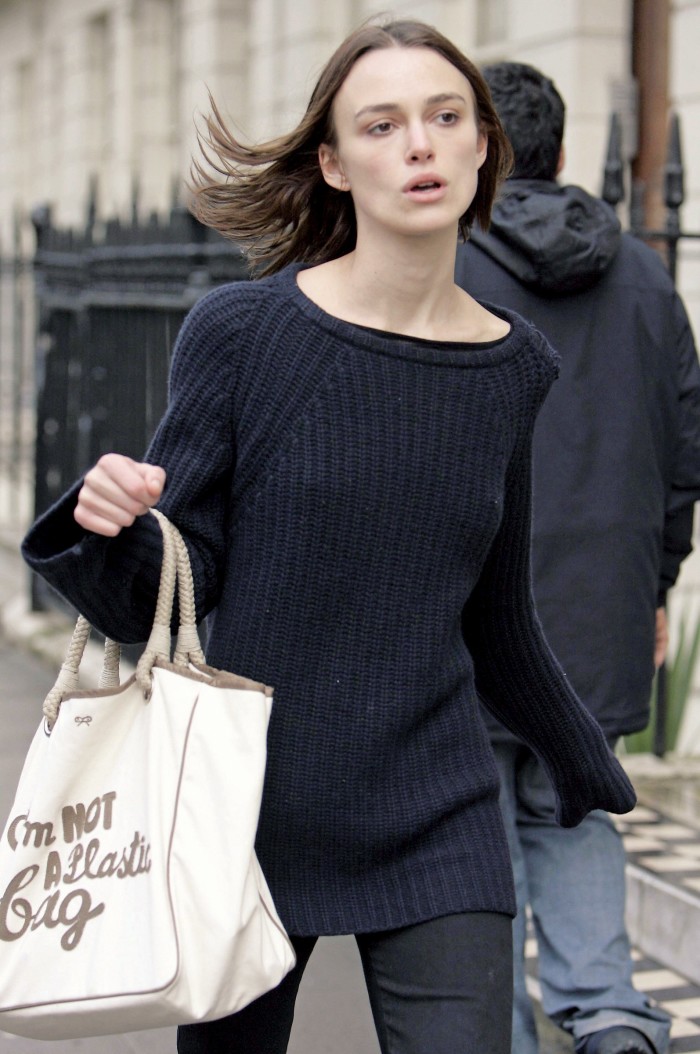Exclusive: Anya Hindmarch launches I Am a Plastic Bag

Simply sign up to the Fashion myFT Digest -- delivered directly to your inbox.
“It just went mad. Properly mad. In the UK, 80,000 people queued in one day. In Tokyo, there was such a stampede, we were locked in a basement. And in Taiwan, 30 people ended up in hospital.” Anya Hindmarch pauses. “It was mental, a really unbelievable project.”
She’s talking, of course, about the 2007 launch of I’m Not A Plastic Bag, the £5 canvas tote she created to raise awareness of the use and the misuse of plastic bags. Thirteen years later, however, her position has changed. This month sees the launch of its counterintuitive progeny: I Am A Plastic Bag.
Crafted from recycled plastic, with a sustainable-leather trim and handles, the carbon-neutral bag engages with the growing conversation around plastics and landfill – in particular with the need for circular and closed-loop manufacturing. It’s an idea – making new products out of old to conserve natural resources, reduce carbon footprints and divert waste from landfill – that is gaining traction. In 2017, Stella McCartney co-hosted the launch of the Ellen MacArthur Foundation’s report, A New Textiles Economy: Redesigning Fashion’s Future, outlining its $500bn vision for the industry remodelled on a circular economy. That same year, Apple pledged to work towards manufacturing its iPhones and other devices entirely from recycled materials: this year, it revealed its progress with Daisy, a robot that disassembles 200 iPhones per hour, harvesting minerals that can be reused.
It took Hindmarch two years to develop a high enough quality rPET plastic (each bag is made from 32 recycled 500ml PET bottles) that had the supple, luxe feel of cotton canvas with a comparable “sense of the warp and the weft”, and a recycled-windscreen laminate that didn’t crack or smudge the ink. “This is an act of real craftsmanship,” says Hindmarch. “When you see them process the bottles – cleaning, emptying, shredding and making them into yarn – it’s fascinating. Like watching amazing embroidery.”

The bag is made in Italy, but Hindmarch turned to Taiwan for fabric production – “which is annoying because I’d love to be able to go more local,” she says. But in many ways it’s a shining example: “Taiwan used to be called Garbage Island. But it really got its act together and now not only do they recycle really efficiently, they have also become world leaders in technologically creating recycled products. It’s the only place in the world we could have created this bag.” The hope is “that we will develop that [technology] here [in the UK] soon. I think it’s closer than we think, as long as we all just get to it. I’m excited by the opportunities.”
Our mountains of waste might feel like an insurmountable challenge to tackle, but Hindmarch’s enthusiasm is infectious – a spirited can-do, you’ve-got-to-start-somewhere attitude shot through with tenacious resolve. “It’s super-exciting. I’m finding the positive,” she says. In the two years following I’m Not A Plastic Bag, the British Retail Consortium helped implement changes that resulted in a 48 per cent reduction in the number of lightweight carrier bags given away per year, down from 13 billion in 2008 (according to Defra). In 2015, the UK government introduced the plastic-bag charging system. Spurring change on a par with or surpassing this is Hindmarch’s motivation the second time around. “As we saw in the original project, if you get people behind change and wanting it to happen, it will. It is happening, but the volume needs turning up.” It’s a rousing call to arms delivered with a warm, matriarchal strength. When she tells you that you’ve got to do something, you can’t help but feel compelled to do it. “If the customer demands change, then the brand demands it of their supplier, then the whole supply chain will change,” she evangelises. “What I’ve learnt while doing this project is that innovation will seize the day. Because when you have to innovate your way out of a problem, you do. I’ve seen it first-hand in supply chains. This is an example of it.”
One obstacle for Hindmarch was the trim: “Recycled leather is leather that’s mashed up, mixed together and put together again – but with plastic. So that was a no. And vegan leather is also plastic. So the answer for us was a completely traceable leather-supply chain.” A Gold Standard Leather Working Group certification on leather from an Italian tannery was “as good as it gets in terms of non-polluting non-solvents”, says Hindmarch, and meant that “in terms of sustainability, it was the most sensible and most respectful option”.

If conflicting ideas for best practice incite backlash for the project, Hindmarch is prepared. “A lot of people fear that taking action can open them up to criticism. But you have to crack a few eggs to make an omelette. And we must all do something, even if it’s not perfect.”
The mania over I’m Not A Plastic Bag brought with it waves of criticism: “We were very proud of it, but it was a baptism of fire. We suddenly had the world’s press camped on our doorstep, people ringing me on my mobile, being quite threatening about the bags being resold for £500. Saying it was a sham. But it was simply about using the platform to say ‘we all have to change’. I’m not saying our bag was the solution, although of course a reusable shopping bag is a good solution; it was about raising awareness.”
At £5, that bag lost the company money, although it simultaneously transformed its fortunes. By contrast, two I Am A Plastic Bags, in limited-edition orange and grey, launch this month – at Net-a-Porter and Anya Hindmarch stores in London and Tokyo – for a significantly more hefty £595, rising to £695 with personalisation. If the first bag was about raising mass awareness, this is a more nuanced brief – about changing the system and inspiring production innovation.
“It has been very expensive to do this. That’s been one of the challenges,” says Hindmarch. “But as I said, this is an act of real craftsmanship. The customer has to pay more and the brand has to be less focused on profit.” A wider selection in four colours arrives at Matchesfashion.com and the Anya Hindmarch flagship in Paris on 22 April, the 50th anniversary of World Earth Day, alongside a range of smaller items, such as make-up bags and lanyard-style wallets.

It’s a bold statement from Hindmarch, who last year took back the managing-director reins after eight years. The move follows the purchase by the Marandi family (which also has stakes in Emilia Wickstead and Soho House) of a stake in the company from Mayhoola for Investments, the Qatari royal family’s fund. Hindmarch and the Marandis are now joint owners. Hindmarch’s mission of “turning around the business” to make it “future-proof” following a turbulent few years, as she told the FT last year, has begun in earnest – though sales dropped from £37.2m in 2017 to £24.7m in 2018, annual losses reduced from £28.3m to £12.5m.
A new strategy combining a digital pivot with more direct-to-customer pop-up events also prioritises her eco values. Hindmarch’s learnings from this latest project have “become the bedrock for informing the rest of the company behaviourally”, such as cutting back on unnecessary packaging, note cards and receipts, and joining the Better Cotton Initiative, the largest cotton-sustainability programme in the world. She is keen that the company prioritises insetting, the companion to offsetting, “which is the idea that within your supply chain you are not just no longer depleting the earth of resources, but you’re actually replenishing it – so as well as planting a lot of trees, you’re also saying how could we help the farmers who grow the cotton, or the people who make the bottles into fabric, flourish into a long-term and sustainable business.”
“What Anya is doing is high quality – an offset-verified project with certificates that will be surrendered into registry so that nobody else can use them, and they’ll never be double-counted,” says Stuart Lemmon, managing director for north Europe of sustainability consultant EcoAct, which has worked with clients including Coca-Cola, Unilever and Gabriella Hearst. “The bag itself is really important in terms of demonstrating the circular-economy approach – which is a valid one and a practicable one. The disappointing thing about climate change is there is no silver bullet. But if everybody acts, then we have a chance of limiting temperature rises to 1.5 degrees or below.”
To celebrate the first-wave launch of bags, Hindmarch will be closing her shops and filling them with plastic bottles salvaged from a First Mile recycling plant. Known for her interactive and immersive product launches – from the Instagrammable inflatable chubby hearts around London to the series of talks on sleep, mindfulness and meditation atop a giant cloud installed in Banqueting House – Hindmarch has decided to collect a mass of bottles representing the waste generated by a family, to emphasise that “when you throw something away, there is no away. If you filled your garden with your own plastic bottles and had to keep digging down to squash them, you wouldn’t do it any more. People need to connect to what’s going on.”
“We can all crack this, because we’re creative and we will,” she concludes. “But people need to change the way they behave – act more sensibly, more responsibly, be more aware. And also, for brands, success has to mean the positive values they stand for.”
Comments